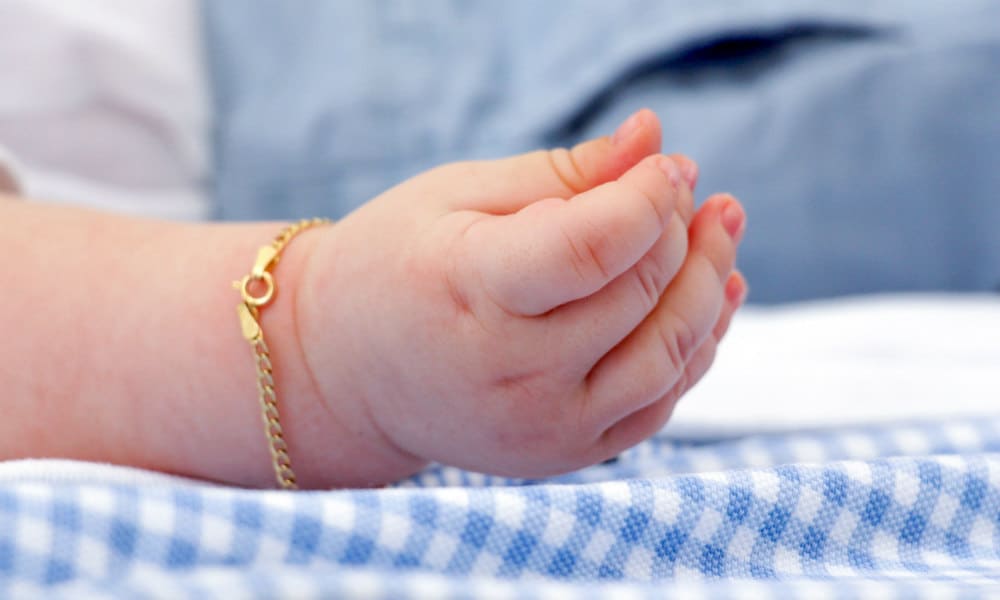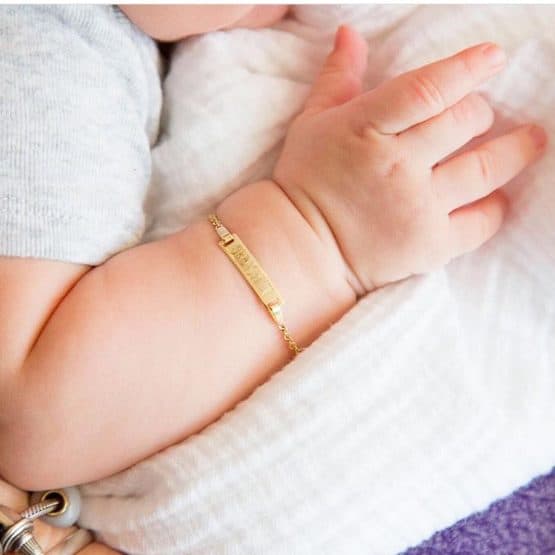Kids´jewelry: it´s not just trendy, it´s traditional

More and more parents (and grandparents) are buying jewelry for their very young children (and grandbabies) – even newborns. It may seem that this is a recent trend, triggered by families’ desires to show off their social status or to simply have an excuse to buy gifts for the new arrival. However, the gifting of baby jewelry is actually a tradition which dates all the way back to ancient cultures.
Today’s most popular baby girl jewelry selections are primarily accessories like bracelets and anklets, although some parents have their heart set on necklaces and pendants, and others (particularly in Spanish, Latin American and American Latino cultures) can’t wait to buy their baby her first pair of earrings. Buying baby boy jewelry is becoming more common as well.
Before getting to some of the best jewelry for babies that’s currently available, let’s look at the rich history of this tradition.
THE HISTORY OF JEWELRY FOR CHILDREN
Well before the modern era, many civilizations celebrated the practice of giving newborns jewelry for decorative purposes and also to protect against evil spirits. This was traditional throughout the world, from Africa to Asia, Oceania to Europe, and in Native American cultures as well. In the earliest days, infants were gifted with jewelry made from shells and animal hair, while evidence of elaborately crafted baby jewelry made from gold or silver filigree, enamels or precious stones has been found by archaeologists and historians researching ancient Egyptian, Babylonian, Roman and Byzantine civilizations. There are also many recorded references to baby and children’s jewelry, ranging from historical writings to the Bible.
For centuries, parents in Cambodia have placed silver strings with small bells on their babies’ ankles, both to keep track of the child’s whereabouts and to ward off evil. Throughout history, some African cultures have used decorative jewelry to begin the process of stretching their babies’ earlobes or lower lips, in keeping with their traditions. Beginning in the 1300s, Italian parents gave their newborn babies crosses made from coral; it was believed to protect the young children from the dreaded “evil eye”.
Jewelry-making became a popular art in 17th century Europe, and many craftsmen began making tiny silver or gold diaper or baby bib clips during that time. But the crafting of baby jewelry reached new heights in England during the Victorian period. Most common were gold (or sometimes silver) bracelets with an engraved plate, usually inscribed with the word “baby”. Often, the lettering was made of enamel, which was used to create flower decorations on the bracelets as well. Wealthy families were fond of presenting newborns with jeweled brooches, also engraved with “baby”. Some of these pieces have survived either as family heirlooms or in museum displays, and the styles have inspired many designs of modern-day baby jewelry which can be purchased today.
The practice spread to America, although in different forms. Tiny gold clips were sold as “baby pins” and used primarily to replace small buttons on baby girls’ clothing, and a custom related to the Italian coral jewelry mentioned earlier was seen in parts of the United States during the 1800s and 1900s, with small coral-bead necklaces given to infants for protection against evil and disease, as well as for teething.
In many South American, Latin American and South Asian cultures, it is not only acceptable for baby girls to have their ears pierced shortly after birth, it is expected. There are conflicting reports about when this custom originated in various nations, but most say that the tradition originated as a way to differentiate between sexes because infant earrings are not considered appropriate baby boy jewelry. One of the great joys for parents, grandparents or godparents in these cultures is to buy an infant her first set of gold earrings; there are even hospitals in some South American nations where an infant girl cannot be discharged until her ears are pierced.
IS IT A GOOD IDEA?
We know a lot more about health and safety than our ancestors, which leads to the question: is it a good idea for a baby to wear jewelry?
There’s no medical argument against baby jewelry, assuming that basic precautions are taken. Babies can have the same allergic reactions to some substances as adults, and their skin is even more sensitive. For that reason it’s important to watch carefully for any signs of rashes or allergies, and it’s smart to avoid any jewelry made from base metals, alloys or synthetic fibers because those can easily irritate a newborn’s skin. There are also no practical reasons to avoid piercing a baby’s ears, as long as someone medically competent performs the piercing.
The biggest issue parents should focus on is safety. Of primary concern are necklaces; they’re sometimes given as baby jewelry gifts, and can be a major choking hazard. Some parents feel that baby chokers are safer because it’s more difficult for an infant to get her hands twisted up in the necklace, but experts say those may pose even more danger because there’s very little room for error if the choker should get caught on a corner or edge. They suggest waiting until a child is older before giving her any sort of necklace, and definitely not putting a choker on a baby. Other potential dangers are the charms or beads which may be attached to a necklace, bracelet (or even an anklet – remember, babies love to put their feet in their mouths) which can come loose and be a choking hazard, so it’s best to steer clear of those pretty, dangly but dangerous charms. Loose clasps can be an issue as well, since once a bracelet or anklet comes loose there’s a good chance it could end up in a baby’s mouth; always opt for safety clasps and check them often. Finally, anything worn around an infant’s arms or legs could easily catch on a changing table or high chair and create a dangerous situation, so it’s best to choose tightly-fitting bracelets or anklets. Whenever a baby is wearing jewelry, it’s important to use common sense along with careful supervision and regular inspection for safety issues. Many manufacturers themselves recommend that you never leave a baby unattended if they are wearing any sort of jewelry.
Having covered all of that, “is baby jewelry a good idea?” becomes simply an aesthetic question. Considering the huge popularity in baby girl jewelry these days (as well as all of the jewelry now available for male infants), a large number of people obviously feel it’s a terrific idea. The rest of this article is for them.
BABY GIRL JEWELRY IDEAS
There are a number of ways to go if you’re looking to buy a piece of jewelry for a baby girl: bracelets, anklets, earrings, and necklaces are the most popular choices. Here are some thoughts on each.
- Bracelets: Few things look cuter than a tiny gold or silver bracelet on an infant’s still-pudgy wrist. It’s a gift which will quite possibly be passed down through a family for generations, or given a place of honor in a bedroom or on a mantelpiece once the child outgrows it. Many parents choose a bracelet which has one or more small birthstones on it, reflecting the month their daughter was born. It’s important to avoid cheaper metal alloys and stick with precious metals for baby jewelry, though, because they will always be free of hazardous contaminants and least likely to cause skin irritation. 14 carat gold, sterling silver and platinum are hypoallergenic and considered the safest materials for baby girl jewelry. You can find a wide selection of these adorable bracelets with cut-out hearts, ID plates for inscriptions, or charms. Pearls are also considered safe for infants, and there’s a wide assortment of tiny pearl bracelets available for newborns. Again, babies should always be under close supervision when wearing this type of jewelry.
- Anklets: There are many varieties of baby anklets for sale, and they’re one of the most popular choices as baby jewelry because they pose the least danger to infants. Many are marketed as “baby’s first anklet” products, and you can find them in simple gold and silver designs, more ornate pieces with birthstones, other semi-precious (or even precious) stones, crystals and all sorts of charms. Some of the largest selections can be found from merchants who specialize in Asian jewelry, since baby anklets are an extremely common gift in many Asian countries. Be careful where you shop, though, because not all countries have the same stringent regulations enacted in the United States and other Western nations prohibiting the use of lead in products intended for use by children.
- Necklaces: You won’t find the same large selection of baby girl necklaces as you will for bracelets or anklets; most commercially-produced necklaces are designed for girls who are at least toddlers. That’s primarily because of the safety issues we’ve already discussed. If you do find one that’s properly-sized, however, many experts suggest extension chains so there’s less danger of the infant accidentally choking. What are easier to find are clunkier, mouth-safe necklaces which are intended to double as gum massagers or teething appliances. They’re certainly not a fashion statement, but more appropriate – and fun – for babies. In any event, infants should never be left alone while wearing a necklace.
- Earrings: Looking for pretty earrings for a newborn? That won’t be a problem. Tiny studs in the shapes of hearts, flowers, stars, butterflies, bows and other cute designs, as well as religious symbols, are ubiquitous on the web and available in many stores which specialize in earrings and piercings. They range from inexpensive cubic zirconia and similar materials, to the always-popular pearls, to stones such as rhodolite, topaz, aquamarine, rubies and even diamonds (if you have the budget). 14 carat gold is always the best choice for baby girl earrings, in order to minimize the chance of irritation or infection, and screwbacks are preferable to ensure that the earrings won’t fall out within reach of a curious baby’s exploring hands.
- Religious: There are many choices when it comes to religious baby jewelry. Christening and baptism bracelets can be found at most religious stores as well as online, as can tiny Star of David necklaces (and you know the caveats about babies and necklaces by now).
- Alternatives: Some who would like to give a gift of baby jewelry but are a bit skittish about safety issues have found there are several alternatives which fit the bill: baby sandals with glitzy decorations such as imitation gemstones, shiny headbands which can add the same sparkle as a necklace or earrings, or small decorative pins which can be securely attached to the infant’s dress or blouse. There is also jewelry available for just about every culture; for example, the evil eye pin which is traditionally attached to the back of clothing worn by babies born in Greece and Turkey is easily found online. There’s really no limit to what you can give; after all, if a gift is intended as a beautiful, thoughtful present for a newborn, no one says it has to be traditional baby jewelry.
BABY BOY JEWELRY
Over the years, baby jewelry has been designed primarily for girls. However, gifts of baby boy jewelry are becoming more common. With a little searching, you can find masculine-looking baby bracelets in ID, bangle or many other styles (some even with the infant’s name spelled out in tiny blocks), anklets, and dog-tag or other personalized necklaces (all of our previous safety warnings apply to these as well). Baptism or other religious baby jewelry is also widely available for boys. The one thing you will have difficulty finding is earrings specifically designed for male infants, because even in cultures where every newborn girl has her ears pierced, the custom still does not extend to newborn boys.
Ref: Santayana

